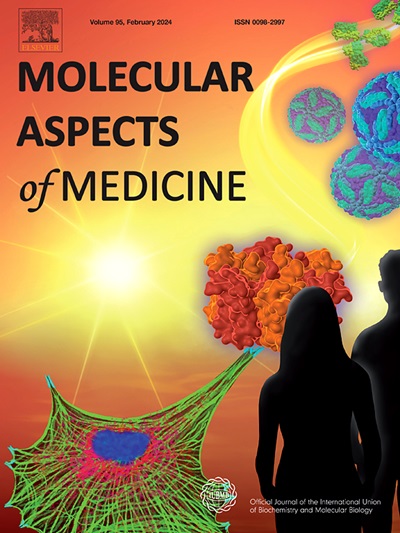Interactions between pathological and functional amyloid: A match made in Heaven or Hell?
IF 10.3
2区 医学
Q1 BIOCHEMISTRY & MOLECULAR BIOLOGY
引用次数: 0
Abstract
The amyloid state of proteins occurs in many different contexts in Nature and in modern society, ranging from the pathological kind (neurodegenerative diseases and amyloidosis) via man-made forms (food processing and – to a much smaller extent - protein biologics) to functional versions (bacterial biofilm, peptide hormones and signal transmission). These classes all come together in the human body which endogenously produces amyloidogenic protein able to form pathological human amyloid (PaHA), hosts a microbiome which continuously makes functional bacterial amyloid (FuBA) and ingests food which can contain amyloid. This can have grave consequences, given that PaHA can spread throughout the body in a “hand-me-down” fashion from cell to cell through small amyloid fragments, which can kick-start growth of new amyloid wherever they encounter monomeric amyloid precursors. Amyloid proteins can also self- and cross-seed across dissimilar peptide sequences. While it is very unlikely that ingested amyloid plays a role in this crosstalk, FuBA-PaHA interactions are increasingly implicated in vivo amyloid propagation. We are now in a position to understand the structural and bioinformatic basis for this cross-talk, thanks to the very recently obtained atomic-level structures of the two major FuBAs CsgA (E. coli) and FapC (Pseudomonas). While there are many reports of homology-driven heterotypic interactions between different PaHA, the human proteome does not harbor significant homology to CsgA and FapC. Yet we and others have uncovered significant cross-stimulation (and in some cases inhibition) of FuBA and PaHA both in vitro and in vivo, which we here rationalize based on structure and sequence. These interactions have important consequences for the transmission and development of neurodegenerative diseases, not least because FuBA and PaHA can come into contact via the gut-brain interface, recurrent infections with microbes and potentially even through invasive biofilm in the brain. Whether FuBA and PaHA first interact in the gut or the brain, they can both stimulate and block each other's aggregation as well as trigger inflammatory responses. The microbiome may also affect amyloidogenesis in other ways, e.g. through their own chaperones which recognize and block growth of both PaHA and FuBA as we show both experimentally and computationally. Heterotypic interactions between and within PaHA and FuBA both in vitro and in vivo are a vital part of the amyloid phenomenon and constitute a vibrant and exciting frontier for future research.
病理性和功能性淀粉样蛋白之间的相互作用:天作之合还是天作之合?
蛋白质的淀粉样状态发生在自然界和现代社会的许多不同环境中,从病理类型(神经退行性疾病和淀粉样变性)到人为形式(食品加工和(在较小程度上)蛋白质生物制剂)到功能版本(细菌生物膜,肽激素和信号传递)。这些类别都聚集在人体内,内源性产生淀粉样蛋白,能够形成病理性人类淀粉样蛋白(PaHA),宿主微生物组不断产生功能性细菌淀粉样蛋白(FuBA),并摄入含有淀粉样蛋白的食物。这可能会产生严重的后果,因为PaHA可以通过小的淀粉样蛋白片段在细胞间以“传递”的方式传播到全身,这可以在任何遇到单体淀粉样蛋白前体的地方启动新淀粉样蛋白的生长。淀粉样蛋白也可以在不同的肽序列中自我和交叉种子。虽然摄取的淀粉样蛋白不太可能在这种串扰中起作用,但FuBA-PaHA相互作用越来越多地与体内淀粉样蛋白的繁殖有关。由于最近获得了两种主要富菌CsgA(大肠杆菌)和FapC(假单胞菌)的原子水平结构,我们现在能够理解这种串扰的结构和生物信息学基础。虽然有许多关于不同PaHA之间同源性驱动的异型相互作用的报道,但人类蛋白质组与CsgA和FapC没有显著的同源性。然而,我们和其他人已经发现了FuBA和PaHA在体外和体内的显著交叉刺激(在某些情况下抑制),我们在这里根据结构和序列进行合理化。这些相互作用对神经退行性疾病的传播和发展具有重要影响,尤其是因为FuBA和PaHA可以通过肠-脑界面接触,反复感染微生物,甚至可能通过侵入性生物膜进入大脑。无论FuBA和PaHA首先在肠道还是大脑中相互作用,它们都可以刺激和阻止彼此的聚集,并引发炎症反应。微生物组也可能以其他方式影响淀粉样蛋白的形成,例如通过它们自己的伴侣识别和阻止PaHA和FuBA的生长,正如我们在实验和计算中所显示的那样。体外和体内PaHA和FuBA之间和内部的异型相互作用是淀粉样蛋白现象的重要组成部分,也是未来研究的一个充满活力和令人兴奋的前沿。
本文章由计算机程序翻译,如有差异,请以英文原文为准。
求助全文
约1分钟内获得全文
求助全文
来源期刊

Molecular Aspects of Medicine
医学-生化与分子生物学
CiteScore
18.20
自引率
0.00%
发文量
85
审稿时长
55 days
期刊介绍:
Molecular Aspects of Medicine is a review journal that serves as an official publication of the International Union of Biochemistry and Molecular Biology. It caters to physicians and biomedical scientists and aims to bridge the gap between these two fields. The journal encourages practicing clinical scientists to contribute by providing extended reviews on the molecular aspects of a specific medical field. These articles are written in a way that appeals to both doctors who may struggle with basic science and basic scientists who may have limited awareness of clinical practice issues. The journal covers a wide range of medical topics to showcase the molecular insights gained from basic science and highlight the challenging problems that medicine presents to the scientific community.
 求助内容:
求助内容: 应助结果提醒方式:
应助结果提醒方式:


